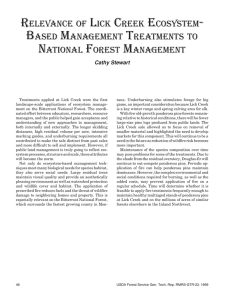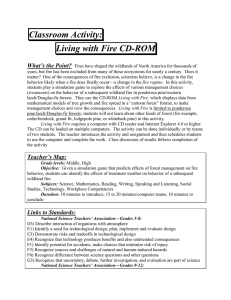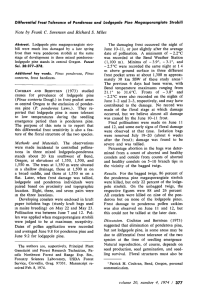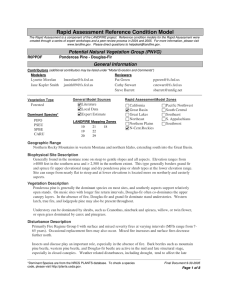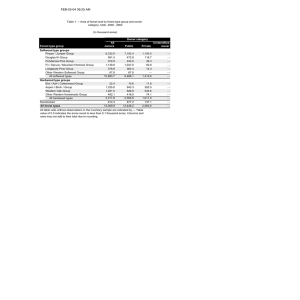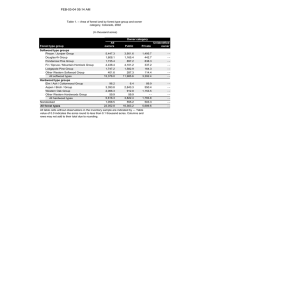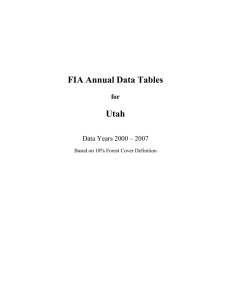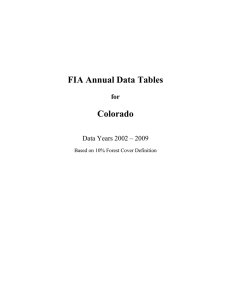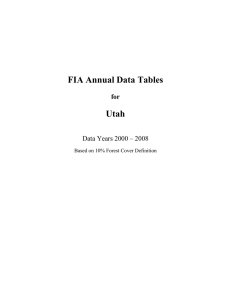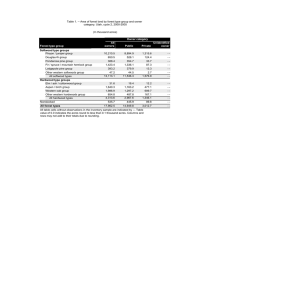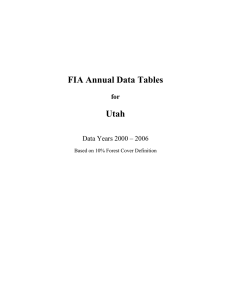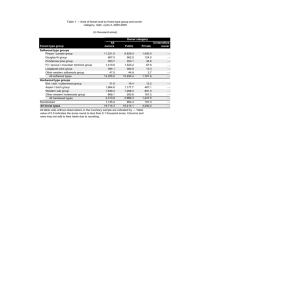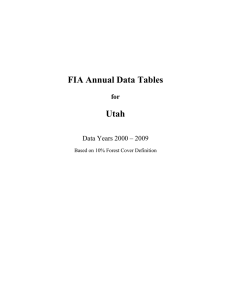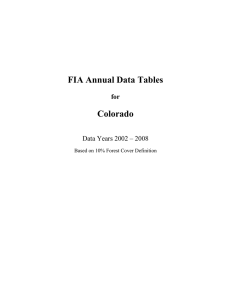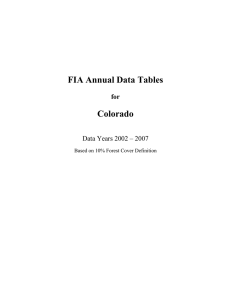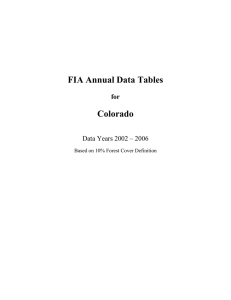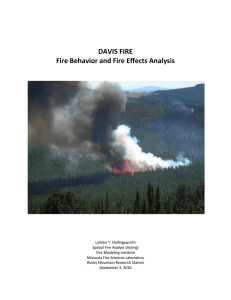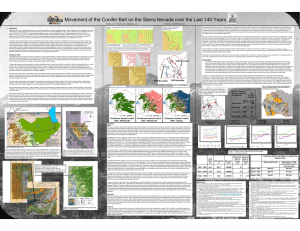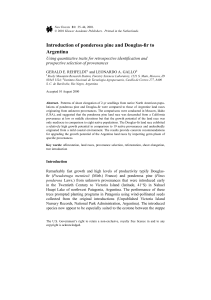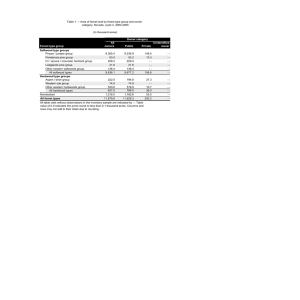- Many Ways to Manage Lodgepole Pine forests by u
advertisement
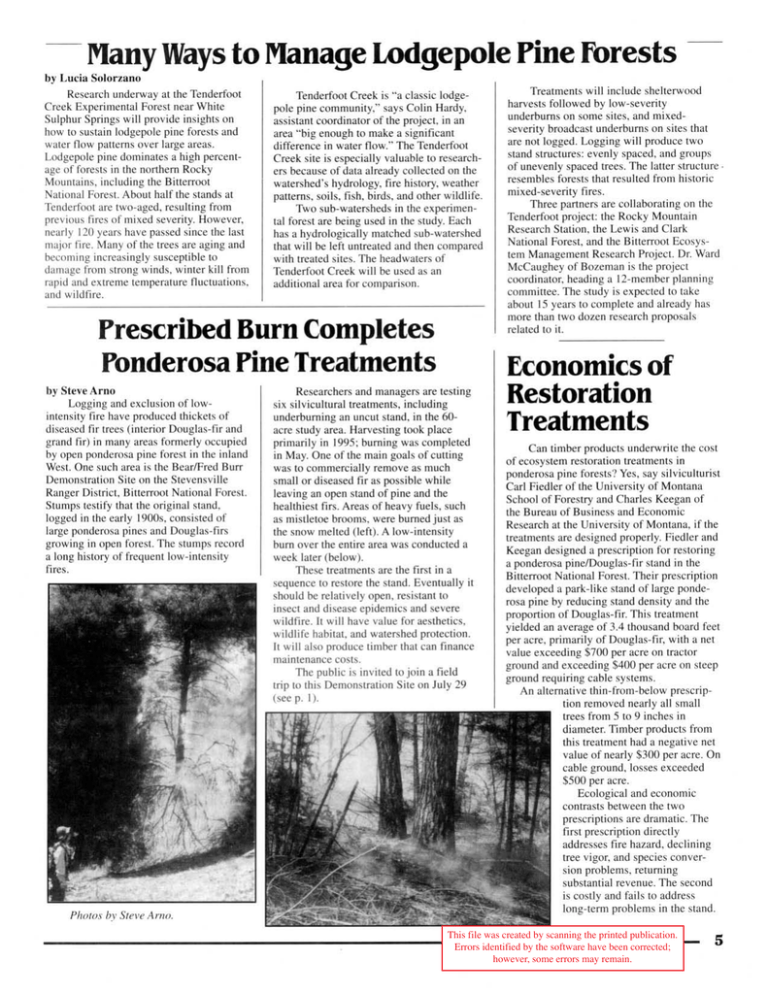
- Many Ways to Manage Lodgepole Pine forests - by Lucia Solon:a nu Research underway at the Te nderfoot Creek Experimental Forest ncar White Sulphur Springs will provide insights on how 10 sustain lodgepole pine foresls and wate r flow patterns over large areas. LoJgepole pine dominates a high percentage of forests in the nonhern Rocky Mountains. incl uding the BiHcrrOO\ National Forest. About hal f the stands at Tenderfoot arc two-aged, resulting from previous fi res of mixed severit y. However, nearly 110 years have passed si nce the last major fire. Many of the trees are agi ng and becoming increasingly susceptible to damage from strong winds, winler kill from rJpid and e xtreme tempe rature fluc tuations. and wi ldfire. Tenderfoot Creek is "a classic lodgepole pille community:- says Colin Hardy, assistan t coordinator of the project. in an area "big enough to make a significant difference in water flow." The Tende rfoot Creek site is espcrially valuable to researchers because of d,lIa already collected on the wate rshed's hydrology. fire history. weather patterns. soils. fi sh. birds. and other wildlife. Two sub-wate rs heds in the experimental forest are being used in the stud y. Each has a hydrologically matched sub-watershed that will be Jeft un treated and then compared with treated sites. The headwaters of Tenderfoot Creek will be used as an additional area for comparison. Prescribed Burn Completes Ponderosa Pine Treatments by Stc\'e Arno Logging and exclusion of lowintensity fire have produced thic kets of diseased fir tfees (interior Douglas-fir and g rand fir) in ma ny areas fonnerly occupied by open ponderosa pine forest in the inland West. One such area is the BearlFred Burr Demonstration Site on the Stevensville Ranger District, Bitterroot Na tional Forest. Stumps testify tha t the original stand, logged in the early 1900s. consisted of large ponderosa pines and Do uglas-fi rs growing in open forest. The Slumps record a long history of frequent low-intensity fires. PhOlOii by Stew> Amo. Researchers and managers are testing six silvicultural treatments. including underburning an unc ut stand. in the 60acre study area. tiarvesting took place primarily in 1995; burning was completed in May. One of the main goals of cutting was to commercially re move as much small or diseased fir as possible while leaving an open stand of pine and the healthiest firs. Areas of hea vy fuels. such as mis tletoe brooms. were burned j ust as the snow melted (left). A lo w-intensity bum over the entire area was conducted a week later (below). These treatments are the first in a sequence to restore the stand . Eventually it should be relati vely opeo. resistant to iosect and disease epidemics and severe wildfire. It will have value for aesthetics. wildlife habitat. and watershed protection. It will also produce limber that can finance maintenance costs. The public is invited to joi n a field trip to this Demonstration Site on Jul y 29 (see p. I). Treatme nts will include shelte rwood harves ts followed by low-severity underburns on some sites. and mixedseverity broadcast underburns on sites that arc not logged. Logging will produce twO stand structures: evenly spaced, and groups of une ve nl y spaced trees. The laller structure · resembles forests that resulted from hi storic mixed-severity fire s. Three partners are collaborating on the Tenderfoot project: the Rocky Mountain Research Station. the Lewis and Clark National Forest. and the Bitterroot Ecosystem Management Research Project. Dr. Ward McCaughe y of BOleman is the project coordinator. heading a 12-me mbcr planning committee. The stud y is cxpel:ted to take about 15 years to complcte and already has more than two dozc n researc h proposals relatcd to it. Economics of Restoration Treatments Can timber products underwri te the cost of ecosystem restoration trea tments in ponderosa pine forest s? Yes. say silviculturist Carl Fiedler of the University of Montana Sc hool of Forestry and Charles Keegan of the Bureau of Business and Economic Research at the Uni ve rsity of Montana. if the treatments are des igned properly. Fiedle r and Keegan designed a prescription for restoring a ponderosa pine/Douglas-fir stand in the Bitterroot National Forest. Their prescription developed a park-like stand of large ponderosa pine by reducing stand density and the proportion of Douglas-fir. This treatment yielded an average of 3,4 thousand board feet per ac re, primarily of Douglas-fir. with a ne t value e xceeding $700 per acre on tr.letor gro und and exceedin g $400 per ac re on steep ground requiring cable systems. An alternative thin-frorn -below prescription removed nearly all small trees from 5 to 9 inches in diameter. Timber products from this treatment had a negative net value of nearly $300 per acrc. On cable grou nd. losses exceeded $500 per ac re. Ecological and economic contrasts between the two prescriptions are dramatic . The first prescription direc tl y addresses fire hazard. decl ining tree vigor. and species conve rsion problems. returning substantial re venue. The second is cost ly and fails to address long-term problems in the stand. This file was created by scanning the printed publication. Errors identified by the software have been corrected; however, some errors may remain. 5
